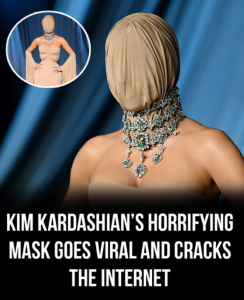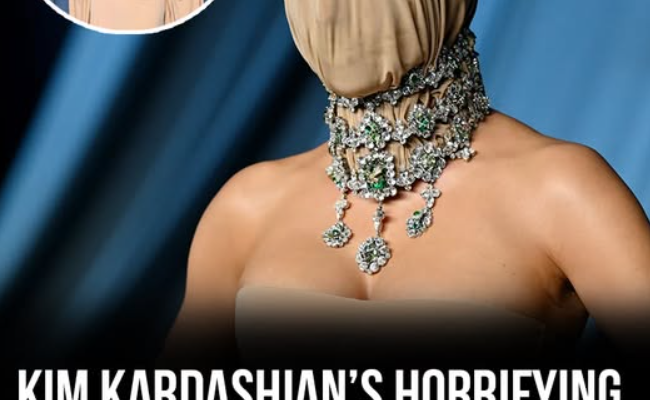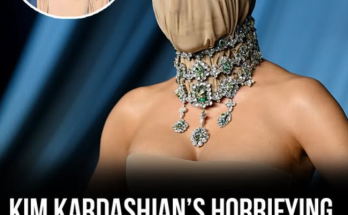Kim Kardashian’s Controversial Mask at the California Gala
The Academy Museum Gala in Los Angeles is known for its glittering red carpet, its parade of couture gowns, and its fusion of Hollywood glamour with high fashion. But this year, one appearance eclipsed all others. When Kim Kardashian arrived in a full nude-toned Maison Margiela gown complete with a head-covering mask, the reaction was immediate and explosive. Cameras flashed, fans gasped, and within minutes the images were everywhere online. To some, it was avant-garde art; to others, it was baffling or even unsettling. Few looks in recent memory have divided opinion quite so sharply.
The gown itself was unmistakably couture. Designed by John Galliano for Maison Margiela’s Fall 2025 collection, it was a sculpted corset dress in pale beige satin, fitted through the bodice and flaring into a flowing skirt. Matching detached sleeves framed the look. What transformed it from simply elegant to controversial was the full-face mask — the same color as the gown, concealing every feature except the outline of her head and neck. The mask blurred the line between clothing and skin, creating an almost mannequin-like effect.
Photographers initially didn’t realize who it was until publicists announced her arrival. The effect was intentional. At a gala where stars depend on being recognized, Kim Kardashian had chosen to appear anonymous. The paradox of the world’s most photographed woman hiding her face was enough to fuel a storm of commentary before she even reached the door.
According to stylists close to the event, the mask had been part of the original runway presentation. Maison Margiela’s recent couture show explored ideas of anonymity, fragmentation, and the hidden self. Each model appeared partially obscured, their identities erased behind fabric and ornament. Kardashian, who has long admired Margiela’s conceptual approach, decided to wear the ensemble exactly as it had been shown. She reportedly told her team that leaving out the mask would dilute the meaning of the piece.
Still, not everyone in her circle was pleased. Her longtime makeup artist Mario Dedivanović and hairstylist Chris Appleton had flown in to prepare her look, unaware that their work would be completely hidden. Kim later admitted that her team was “not thrilled” but that she felt compelled to commit fully to the designer’s vision. The decision was not about concealing beauty, she said, but about exploring what beauty means when the face disappears.
As soon as she stepped onto the carpet, the fashion press began dissecting the look. Some saw it as bold homage to couture purity. Others found it disturbing. The Washington Post called it “eerie, like a mannequin who wandered off the runway.” Online, fans argued about whether it was empowering or absurd. Memes proliferated comparing the mask to everything from a Halloween costume to a beige ski hood. Within an hour, “Kim Kardashian Mask” was trending across social platforms.
Yet behind the spectacle was a deeper conversation about identity, visibility, and control — themes that have shadowed Kardashian’s career. Since the early days of reality television, her image has been her currency. Every contour of her face has been scrutinized, every red-carpet appearance analyzed. In choosing to hide her face, she seemed to reclaim a kind of privacy through exaggeration, using absence as presence. Some cultural critics interpreted the mask as commentary on the loss of individuality in fame itself: when everyone knows your face, the only rebellion left is to erase it.
Fashion historians pointed out that Margiela has long used masks as symbols of transformation. For the designer, concealing the face allows the viewer to focus on silhouette, craft, and emotion rather than celebrity. Kardashian’s appearance, then, wasn’t simply shock value — it aligned her with a long lineage of performance-art-infused fashion. Still, transferring such a concept from a Paris runway to a Hollywood gala was bound to confuse. The Academy Museum Gala celebrates glamour; masks suggest mystery, even discomfort. In that collision, tension was inevitable.
Critics also noted the practical side: communication becomes impossible when you can’t see someone’s expression. Photographers shouted her name, hoping she would turn. Interviewers couldn’t capture reactions because her words were muffled. The spectacle of a silent, faceless Kim Kardashian under the Los Angeles lights felt like performance art unfolding on the carpet. Even those who disliked it admitted it was unforgettable.
Inside the event, witnesses said she eventually removed the mask for dinner, revealing the flawless makeup hidden beneath. The reveal itself became a second act — a reminder that the beauty she had concealed was still there, just withheld until she chose to unveil it. In a sense, the gesture mirrored her relationship with fame: control the narrative, decide what the public sees, and when.
Public reactions afterward reflected the divide between art appreciation and celebrity expectation. Admirers called it daring and conceptually brilliant, praising her for honoring Margiela’s integrity. Others accused her of turning fashion into spectacle, claiming the look was “pretentious” or “attention-seeking.” But in the economy of modern fame, attention itself is a form of success. Whether you loved or hated it, you were talking about it — and that, as one fashion editor noted, is the real point.
The controversy also highlighted the evolution of red-carpet culture. A decade ago, stars competed to look beautiful; now they compete to look interesting. Outfits are judged less by elegance than by their capacity to start conversations. Kardashian’s mask may have been polarizing, but it cut through the noise of predictable glamour. It reminded audiences that fashion can still provoke rather than merely please.
For Kardashian, the episode fits neatly into her larger narrative of reinvention. She has built a career on control — control over image, body, brand, and perception. In hiding her face, she paradoxically made herself more visible as an idea rather than as a person. The mask became a symbol of both protection and exposure, the tension at the core of her celebrity.
In later interviews, she reflected on the experience with a smile. “Sometimes,” she said, “it’s freeing to not be looked at, even when everyone’s looking.” That paradox may be the truest explanation. For a woman whose appearance has defined public conversation for nearly two decades, the simple act of covering up becomes radical.
The reactions will likely fade, as they always do, but the image will endure — the faceless silhouette of a woman whose fame depends on visibility, standing calmly amid a frenzy of flashing cameras. It encapsulates the strange, symbiotic relationship between celebrity and culture: we look to stars to show us who we are, and when they withhold their faces, we confront our own fascination with them.
Ultimately, the mask was not a gimmick but a mirror. It reflected our obsession with recognition, our discomfort with anonymity, and our endless need to decode celebrity gestures. In a night filled with sequins and smiles, Kim Kardashian dared to appear unreadable. Whether one sees that as brilliance or absurdity may depend less on her intention than on what we expect from her — and from ourselves.

